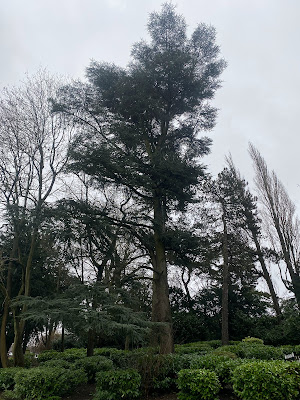Do you know your Christmas Trees? (part 2)
 |
| Fir at Cannon Hill Park possibly Abies grandis |
Winter 'evergreens', a suitable and seasonal distraction in terms of identification, providing a rather more challenging activity than the now fallen broad leaves, although having said that, a tree with no leaves is just as challenging when only buds and bark are at play. Also, the language of evergreens is somewhat different to that of broadleaves, in both biological terminology and description, providing a continual monologue through the year, with a voice that changes less hysterically than its broadleaf distant relatives. The other challenging difficulty of course is the weather, standing with a field guide and key on a cold day is not everyone's idea of fun.
The subject trees related to in this passage are mainly those found locally either at the Cannon Hill Park Tree Trail or at the Highbury Park Pinetum and Highbury Estate.
All of the trees have been introduced with various planting schemes over the past 80 years or so, and most of them are much younger.
Only the Scots Pines and Yews are native to the British Isles, all others have a history of introduction, many arriving for the first time, brought here by collectors in the mid-late 19th Century.
The Highbury Park Pinetum was planted in 1993 by the Townswomen's Guild, and there lies another story, but 30 years later, we have a collection of trees, collectively known as a 'Pinetum', as all belong to the family 'Pinaceae', well, most of them. It's not an easy story to tell or grasp but here goes-
 |
| Surviving trees at the Highbury Park Pinetum, surveyed in 2020 by Ellen Pisolkar |
We have carried out the 'Do You Know Your Christmas Trees' event several times over the past 12 years, with mixed results depending largely on weather conditions .
A little desktop research may be useful before visiting the site, at least to try and grasp the differences between the various families and genera.
The two main families present in the Pinetum are, Cupressaceae and Pinaceae, with the presence of a few trees from the family Taxodiaceae.
For an academic classification reference follow the link-
https://www.newworldencyclopedia.org/entry/Conifer
Tree families to be found at Highbury Park and Cannon Hill Park -
1 Fir (Abies)
2 Cedar (Cedars)
3 Spruce (Picea)
4 Pine (Pinus)
5 RedCedar (Thuja) (None in the Pinetum, but present on the Estate)
6 Larch (Larix)
7. Cypress (Cupressus)
8. Hemlock (Tsuga)
Tree shapes
 |
| Fir (Abies) at Cannon Hill Park |
 |
| Cedar (Cedrus) at Cannon Hill Park |
 |
| Pines (Pinus) at Cannon Hill Park |
 |
| Scale like leaves |
 |
| Underside of Fir needles |
 |
| Some trees have both fern-like and needle-like leaves |
A silver fir sp. at Cannon Hill
- Straight trunk
- Lowest foliage at 40-50 feet
- Sheen on foliage
- fallen foliage
- disintegrated female cones
- possible male cones
 |
| foliage at 40-50 feet |
 | ||
beneath canopy |
 |
A recent introduction to the British Isles when Chamberlain completed Highbury around 1880 |
 |
| Cupressus at Cannon Hill Park Cupressus or 'true' Cypress are a much variegated collection of conifers, relatively easy to hybridise I suspect, but quite accommodating regarding identification. . |
 |
| Handbook of Firs and Pines 1886 |






Comments
Post a Comment